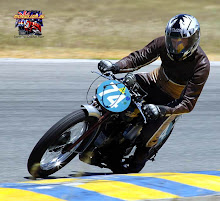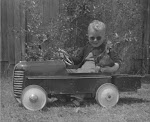While this piece was written last century, the starting technique is ageless. Velocette owners must be patient souls, since getting to know how to interpret the various wheezes, slurps and farts emitting from the intake and exhaust of your Velo during the starting routine takes some time. When to tickle more, when to clear the combustion chamber before trying again. When to give up kicking and resort to the bump start. When to change the plug. The day that you reach that state of union between man and machine is hastened by regular use. And when it arrives, there are few greater satisfying moments in life.
The scene is a Friday evening in October 1993, Tumut NSW (our Snowy Mountains base for the 1993 VOCA Good Companions Rally). Spring is in the air and the Velocettes are rolling into town.Install numerous boxes, suitcases, children, spouse and riding gear in the motel room. Return to the faithful Thruxton sulking out front, having once again missed out on a good, long ride. Frustrated by the straightjacket treatment in the trailer while sweeping bends passed under stationary wheels.
Turn fuel on. Lift rear of fuel tank, slide left hand into the void and reach for the tickler on the remote float bowl (barely possible with an outstretched finger, but preferable to the alternative of a hand full of petrol if attacked from the right). Flood generously. Flick the right footrest up to clear the kickstarter. Retard the spark and give a half-hearted prod over compression. Remove bathplug from the gaping bellmouth. Now with a belly full of rich fuel it is time for the ritual. Find compression, kickstarter back to the top, engage valve lifter, push kickstarter gently, right to the bottom and then return to the top of the stroke. A quick glance reveals 16 eyes watching, waiting - an audience of eight and growing by the minute. Not a good omen. Tell myself to have faith as we’ve done this thousands of times in the last 18 years with a strike rate that has me disbelieving the legend of cantankerous behaviour. Crack the throttle open a whisker and steady the right hand with a two-fingered grip on the front brake. The moment of truth.
A deliberate and well practiced kick is followed by the familiar boomp……boomp….boomp …boomp..boomp as heavy flywheels drag through thick oil. A deft throttle hand catches those first faltering cycles and eventually wins the war of inertia, without snuffing out the fire. Sixteen eyes smile at the sound, as I do my best to appear nonchalant about the whole episode. This was a good start to what would prove to be a great weekend.

Left click on image for high resolution viewing, then use back button to return to Blog
VMT457 at an earlier rally, Bundanoon NSW, 1987. This was 3 year old Phillip's first ride on a motorcycle, as you can tell by the tentative smile on his face.








